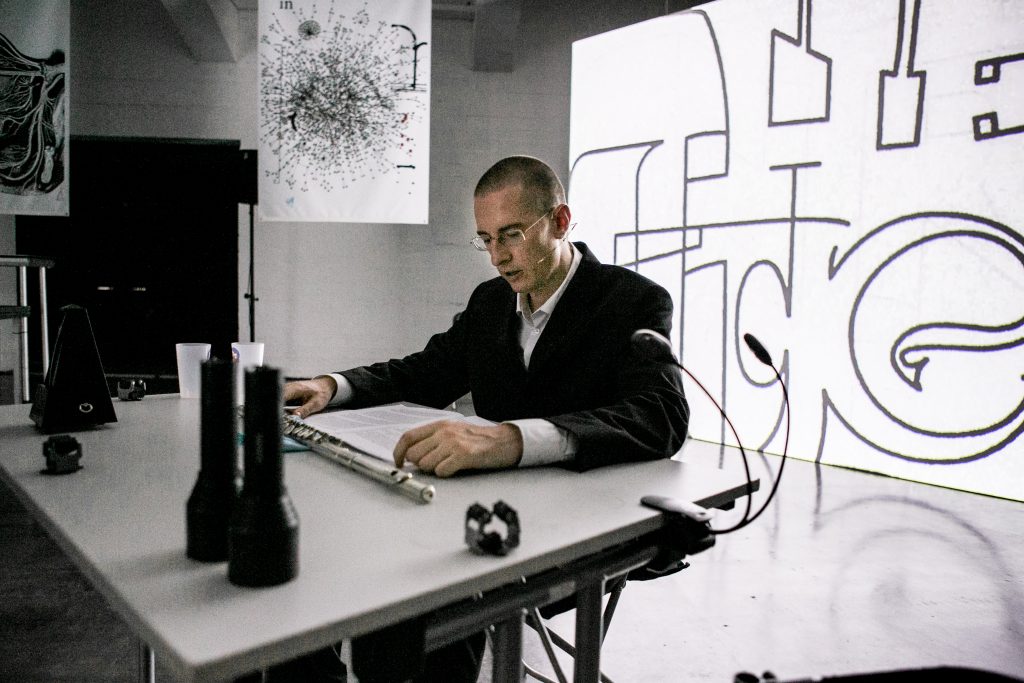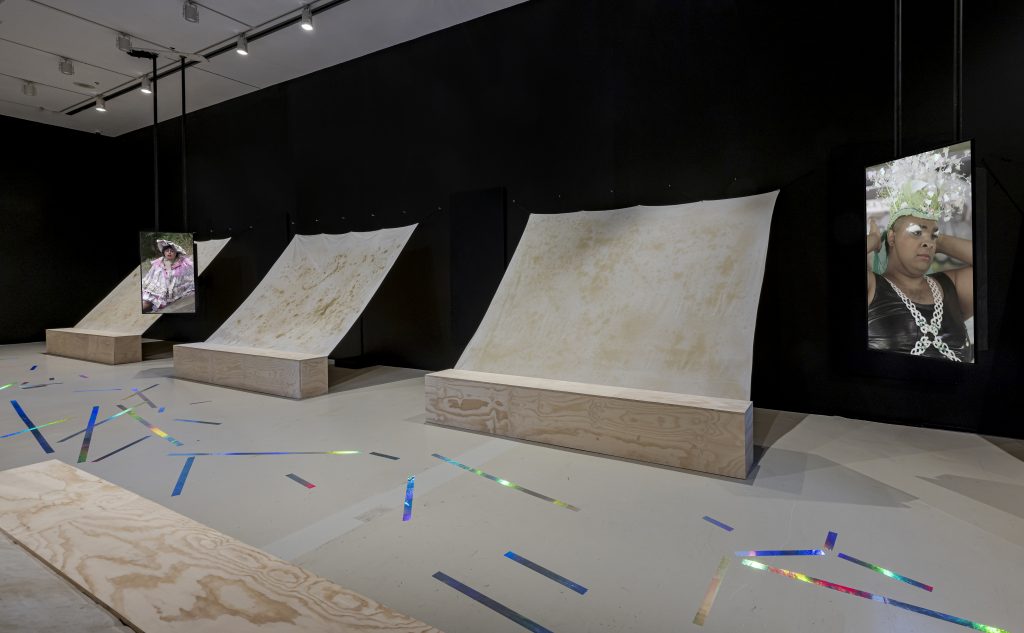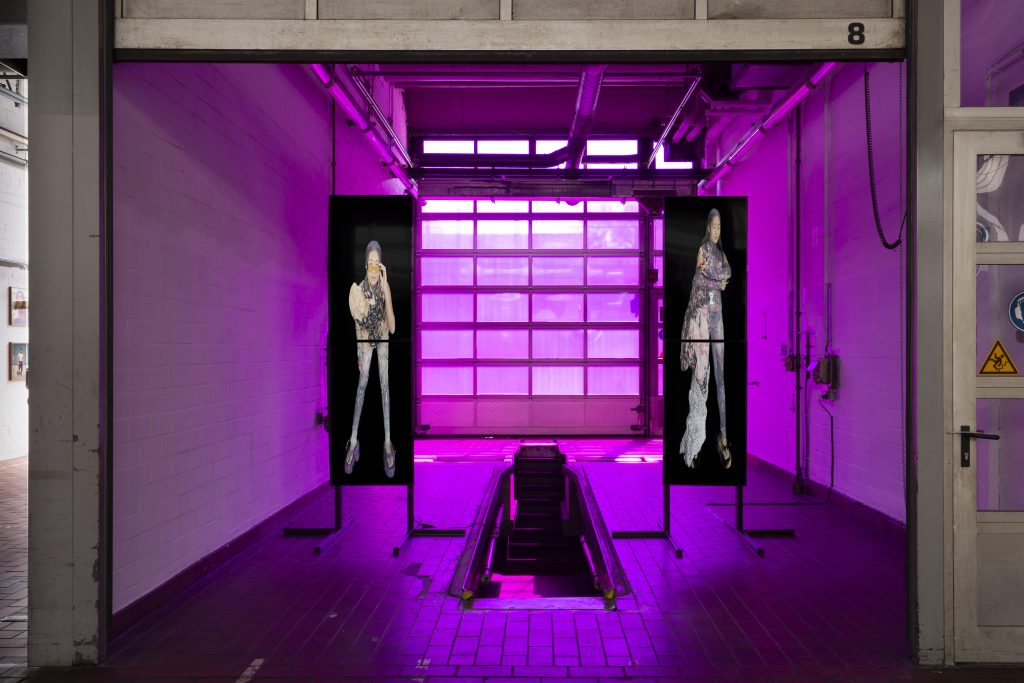Announcement │ #RupertResidents for 2024
Images: (1) Billy Bultheel, Workers in Song, 2023, photo by Tine Declerck; (2) Lou Sheppard, Rites of Passage, 2022, photo by Toni Hafkenscheid; (3) Tra My Ngyuen, Using one’s feet has become an option of last resort II, 2019/2023, photo by Max Eulitz
Rupert hosts over 25 international residencies yearly. Following an open call in the spring, over 600 artists applied. After months of an intensive and careful selection process with invited jury members, Rupert is excited to share the list of 2024 residencies (below).
In the upcoming year, an exciting roster of artists, artist collectives, curators, writers, and interdisciplinary researchers will come to Rupert. Throughout their residency, they’ll nurture and initiate the development of individual projects while immersing themselves in Lithuania’s contemporary art scene both in Vilnius and in other cities across the country. The 2024 cohort will explore concepts ranging from moulding organisations, embodied writing, meditative listening experiences, sound-based experimentations, solastalgia, algorithms, vibrancy as a medium of interspecies communication, weather phenomena, finance and ‘economic shamanism’ to posthuman materialities.
The curatorial team will assist in organising study visits with local art field representatives and encourage engagement in additional activities or events.
The list of announced open call residents will grow over the next year with institutional partnerships and now, invited residents. By the end of 2023, Rupert adds a fresh dimension to its residency agenda. The Invited Residencies Programme introduces opportunities for Rupert’s curatorial team to welcome established artists for short residencies focused on specific research and production in Vilnius.
The first resident for this initiative in December is composer and performance artist Billy Bultheel. They come to Vilnius in preparation to stage a new commission for Rupert in 2024.
Billy’s work as an composer and performance artist is often site-specific, bridging contemporary electronic techniques with the traditions of European Medieval and Renaissance polyphonic music. Billy’s dark, melancholic compositions layer noise, ambient metal, and experimental orchestration.
The participants of the 2024 Rupert Residency Programme:
Calum Bowden
Calum Bowden is an artist moulding organisations as a medium. He co-founded Trust – a network of utopian conspirators and a testing-ground for new ways of learning together – collaborating on worlds, games, and platforms. In this way, Calum builds infrastructures that relink culture, technology, economy, and ecology.
At Rupert, Calum will research historical examples of distributed decision support systems and organisational cybernetics, such as Project Cybersyn. From this, he will develop a new ludic play that explores the limits of collaborative infrastructures.
Ceci Moss
Ceci Moss (United States) is a curator, writer and educator with almost twenty years of professional practice organising solo, group, touring, and online exhibitions, as well as public programs, performances and screenings, in museums, galleries and artist-run spaces. She currently serves as the Director and Chief Curator of the Mandeville Art Gallery at UC San Diego, a non-collecting institute for contemporary art with a five-decade history of presenting innovative exhibitions in the context of a major research university. She also holds a dual appointment as a Professor of Practice in the Department of Visual Arts, where she teaches courses in Museum and Curatorial Studies. Previously, she was the Founding Director of Gas, the Assistant Curator of Visual Arts at Yerba Buena Center for the Arts, the Senior Editor of the art and technology non-profit arts organisation Rhizome, and Special Projects Coordinator at the New Museum of Contemporary Art. She has a MA and PhD in Comparative Literature from New York University, and a BA in History and Sociology from U.C. Berkeley.
She will use the residency to focus on her second book Mutual: Movement Building in the Arts. The book is an anthology of edited conversations with leading artists, curators, critics, activists and theorists that aims to plant seeds for paradigmatic changes within the art sector. By inviting a chorus of voices to address foundational issues such as funding, community, space, tools and time through the frame of today’s compounding crises, readers will become empowered to rethink their own work and orientation to contemporary art practice.
Qu Chang
Qu Chang is a Shenzhen and Hong Kong-based curator and writer. She is currently a PhD candidate at the Cultural Studies department of Lingnan University, researching the discourse of love in post-socialist China. Previously, she served as a curator at Para Site art space Hong Kong.
During her residency, Qu will continue her long-term curatorial research Follow the Feeling, exploring artistic practices that reflect on the production of ‘feeling’ and the making of the subject through touching, moving, singing, and home-making in a post-socialist context.
Gosia Lehmann
Gosia Lehmann (Poland/Germany) is an artist, who works in a research driven approach. Using techniques from film-making and theatre, she explores the interdependent relationship between fact and belief and how arbitrary the distinction between them can be. Staging, re-enacting and performing magic-tricks are her tools to investigate the subjectivity of ‘knowing’.
Gosia is a guest lecturer at Visual Communication and Art and Media departments at University of Arts in Berlin. Her works have been shown among other venues at CYENS Excellence Center in Nicosia, Good Design Week in Tokyo, Klassik Stiftung in Weimar and following venues in Berlin: Natural History Museum, Akademie der Künste and Künstraum Kreuzberg and Bärenzwinger. In 2020 she participated in Goldrausch Female Artist Program, she was awarded a Stiftung Kunstfonds grant in 2022 and first prize Hosek Contemporary Award in 2023, among others.
During her time at Rupert she will continue her research on ‘economic shamanism’ (a term she uses to describe the black magic of the world of finances, which includes economic paradoxes, value fabrication and offshore money ‘disappearing’) and develop riddles, characters and scenography for her performance called Dilemma.
Lithic Alliance
Lithic Alliance (Belgium/ planetary) is a more-than human collective predominantly working with the lithological realm and the energies and vibrations that emerge in this mineralized entanglement. Their research digs into the ecological and geopolitical foundation of co-existence, animisms and the rights of nature resulting in multifaceted projects that investigates connections spanning over vast temporalities to identify phenomenological correspondence and queer kinship.
During their residency Lithic Alliance will investigate vibrancy as a medium of interspecies communication and listening that goes beyond the transformation of traceable signals. Sound synthesis, movement and performances will serve as tools to establish connections and circles of exchange with material others to collectively work on speculations of deep time relationships and near future scenarios.
LOU SHEPPARD
Chorus/Corpus
While at Rupert Lou will be researching traditional Lithuanian folk singing, and how it been used as a point of assembly and unification in Lithuania’s Singing Revolution (Dainuojanti Revoliucija). The shared bodily experiences of choral singers provide a structure for thinking through experiences of expanded bodily boundaries and post-human embodiment: choir members singing together experience synchronous breath, heartbeats and other biorhythms as well as a euphoric sense of being of one single body. The polyphonic harmony structures in Lithuanian folk songs, however, point to possibilities of hybridity and multiplicity within this experience, possibilities that resonate queerly within a more-than-human experience. Lou will use this research to create a series of vocal scores that reflect on these more-than-human, post-human, non-human experiences as possibilities of ecological and political resistance, and speculative queer futures.
Marianna Ellenberg
Marianna Ellenberg is a visual artist, playwright and filmmaker based in Brooklyn, New York. Her creative practice involves rigorous research and a commitment to expanding the medium of multi-media performance to bridge the disciplines of cinema, fine art and theater. Her projects tease the boundaries between the still and moving image, performance and meaning, narrative flow and digitization. Through rigorous language play, mixing found and original material, Ellenberg builds new possibilities for female embodiment and ontological presence within her video installations and live performances. Her work has been performed and presented at The Kitchen, David Lewis Gallery, Joan (Los Angeles), Issue Project Room, LACMA and Anthology Film Archives as well as EMAF in Germany and Gallery SC in Zagreb.
At Rupert, Ellenberg will have the unique opportunity to incorporate primary research into the legacy of Lithuanian Jewish literature and intellectual history, as part of her ongoing project The Rindfleisch Tales. This performance project incorporates chanting, language play, intertextuality and minimalist music to draw the interstices between female jewish embodiment, dis-identification, coming of age and intellectual freedom. In each additional segment of The Rindfleisch Tales, Ellenberg’s draws out tales of jewish female visionaries who challenge the constructs of religion, gender and sexuality. In addition, Ellenberg will write a series of experimental monologues and vignettes, to be workshopped with a group of local performers.
MARIJN DEGENAAR
Marijn Degenaar (NL/DE) is an artist working within the fields of sound, moving image and performance. His work explores dreams and psychedelia, fabricating together nuances of tones, rhythms, and textures to facilitate hypnagogic travels. Interested in magic, mythology, and their relation to non-human intelligence, Marijn aims to create ‘openings’ for different kinds of perceptions, inviting the audience to experience different states of consciousness through his creations. He holds a MA of Fine Arts and Design from Sandberg Institute, Amsterdam.
OXI PENG
oxi peng is a memory being that practices (embodied writing), creates (psychedelic poetry), and dreams (of pink tardigrade) softly. they write with darkness, water, sleep, yōkai, landscape, tentacles, vulnerability and alien resistance of various kinds. shapeshifting among realities, one may discover pieces of oxi in shuyi cao’s as they folded in and breached out, berglind thrastardottir’s sunset peaches, yenchun lin’s here, a nut falls twice, crosslucid’s dwellers between the waters, tianzhuo chen’s trance, 33emybw’s upcoming portal holes of sinian, and…
SHELLS THAT GLOW LIIKE EMBERS
The duo’s shells that glow like aembers is an interdisciplinary soni-mantic research that explores the potentiality of sculpting sound into semantic and spiritual practice which could be exercised collectively to cultivate our aesthetic sensibility. The project seeks to experiment with the act of ‘deep-reading’, coined by the duo, as a process of sonic materialisation to create a meditative listening experience for wandering in the deeper level of (un)consciousness.
Marijn Ottenhof
Marijn Ottenhof (Netherlands / Belgium) is a visual artist and electronic musician. She received her bachelor’s degree in Fine Arts at the Royal Academy of Art in The Hague and her master’s of Fine Arts at the Royal College of Art in London. Her work has been shown internationally in institutions including the South London Gallery, Somerset House, Centraal Museum Utrecht and Stedelijk Museum Amsterdam. She was selected for the 2019 Bloomberg New Contemporaries. She is a core tutor at the Masters Institute of Visual Cultures in Den Bosch and lives and works in Antwerp.
At Rupert she will research and prepare for a new videoproject on solastalgia; a sense of intense sadness about a lost future in the face of climate catastrophe. This project seeks to turn the sense of failure and pessimism into a lyrical format, using electronic music, choreography and video.
monica maria moraru
monica maria moraru (Romania/Canada) is a visual artist whose work seeks within the characteristics of material practice a cinematic expressionism. Her projects often culminate in sculpture, moving-image, installation and sound. Across mediums, she searches for sensorial and political resonances within a patchwork of temporal and relational histories.
While at Rupert, monica will work with writing and sound-based experimentations as a foundation for a new moving image work. Her research will focus on vibrational seismic-isolation technologies and the sonic phenomenon of object resonance frequency as a means to propose alternative understandings of psychic sedimentation and fragmented generational memory. Sampling from the mythic legacy of the Romanian Communist project, her ongoing research seeks to decode how contemporary ecological and state-sanctioned crisis become enfolded in a politics of projection, fantasy, and mythology through sensorial polyphonics.
REN LOREN BRITTON & GODA KLUMBYTĖ
Ren Loren Britton is a trans*disciplinary artist and researcher tuning with practices of critical pedagogy, trans*feministtechnoscience and disability justice. Playing with the queer potential of undoing norms they practice joyful accountability to matters of collaboration, disability access, Black feminisms, instability and trans*politics. They love slugs, slowness, reading, repetition, examining non-linearity and experimenting towards greater accessibility.
Goda Klumbytė is an interdisciplinary scholar working between informatics and humanities & social sciences. Her research engages feminist new materialism, posthumanism, human-computer interaction and algorithmic systems design. She co-edited More Posthuman Glossary with R. Braidotti and E. Jones (Bloomsbury, 2022), and published work in journals ASAP, Digital Creativity, Precog and others. Together Goda and Ren have collaborated in academic, creative and speculative writing projects, such as performing material experiments with cyberfeminist practices for computing, writing about slime mould, critique of technocapitalism, and performing algorithms otherwise.
Algorithms and Slimes (Algorithms-by-Bodies)
In this project duo investigate non-human slime molds and everyday human practices to find companions in our research on and with algorithms. Drawing on their previous work on SliMoSa3 – a critical speculation about future AI technology that operates as a slime mold (Myxomycetes) – they intend to develop a series of speculative algorithms-by-bodies/slimy algorithmic studies as vernacular technological practices that are rooted in human and non-human experiences. They will expand the work on SliMoSa3 as a grounding slimy speculation to explore what algorithms do with the practices of queer organisms, such as slime molds. Ren & Goda intend to find slime mold in the Pavilnys park (e.g. on rotting wood) in Vilnius to observe and consider how it can become a companion in our research on algorithmic thinking. How does slime mold digest and move across decomposing materials and what kinds of slime-based movements might be juxtaposed with step-based algorithmic operations?
Sabina Scorțanu
Sabina Scorțanu (Moldova/Netherlands) is a graphic designer and multimedia artist, whose work emerges from a fascination with the transient nature of phenomena that shape the ecosphere, particularly Earth weather. She constructs tools that react to volatile environments, and reflects on visionary modes of existence in the atmosphere, orchestrating through storytelling acts, shaped by audiovisual works, radiophonic installations, and digital spaces.
At Rupert she will be researching weather phenomena, using the radio spectrum as a medium to visualize and sonify the clashes between terrestrial weather events, and reflect on the way humans build physical and informational infrastructures to shape the atmosphere to their liking.
SUSAN FINLAY
Susan Finlay (UK/Germany) is an artist who writes. Recent books include the anti-memoir The Lives of the Artists (JOAN 2023) and the novel The Jacques Lacan Foundation (MOSIT 2022). Shorter pieces of her work have also appeared or are forthcoming in publications such as POETRY, The Stinging Fly, and the LA Review of Books. During her residency she will work on her first full-length poetry collection. Currently titled Ancient & Modern, it examines the legacy of modernist architecture—both its successes and failures—in a manner specific to this current, late-capitalist point in time.
Tom Clark
Tom Clark is a curator and writer. He teaches at Goldsmiths, University of London and Manchester School of Art and has worked on curatorial and publishing projects internationally. He submitted his PhD Thesis in Art, Curating and Infrastructure at Goldsmiths, University of London, in 2022 where his research explored infrastructural figures, politics and imaginaries as they relate to critical practices in the institutions of art.
He has been editor at BAK, basis for actuelle kunst, Utrecht (2015–2017); co-director of the self-organised project space Arcadia Missa gallery, London (2010–2015); and his writing has been published in collections published by Sternberg Press and Bloomsbury Academic.
While on the Rupert Residency he will undertake an R&D period exploring how cura-infrastructural imaginaries/models of public making can be used in real world infrastructural-environmental settings of the local & international publics of Rupert. This will mean developing writing, research and dialogues on the integration of environments, resources & communities into & as the infrastructures that pass through this scene. I will focus on how these exert a twin pressure of, slow violence, control & reductionism but also of generative reinterpretations of the possibilities of shared life. In practice, I will seek to write, carry out workshops and initiate a collaborative platform to collate and share visualisation, tests and prototype cura-infrastructural modelling based on the time I spend in Lithuania.
Tra My Nguyen
Tra My Nguyen is a Berlin-based visual artist whose multidisciplinary practice encompasses sculpture, moving image, and textile. Drawing upon diaspora perspectives, her work re-contextualizes material culture within global modernism. Nguyen’s practice engages with speculative narratives to explore the intersection of gender, labor, migration, and technology within the current neoliberal order.
Her work has been exhibited internationally, including at the 4th Edition of Bienalsur in La Plata (AR), Bundeskunsthalle Bonn (DE), Human Resources in Los Angeles (US), the State of Fashion Biennial in Arnhem (NL), and VCCA in Hanoi (VN).
During the residency, Nguyen will explore the significance, symbolism, and socio-cultural impact of plastic in Asia, particularly among Asian diaspora communities. Drawing on Plastic Asia: Material Ambiguities and Cultural Imaginaries by Saskia Abrahms-Kavunenko and Trine Brox (2022), the project Crafting Ambiguities investigates the interplay between modernity, waste colonialism, migration, and plastic production. While at Rupert, she will conduct research on the project and create prototypes of the sculptures.


